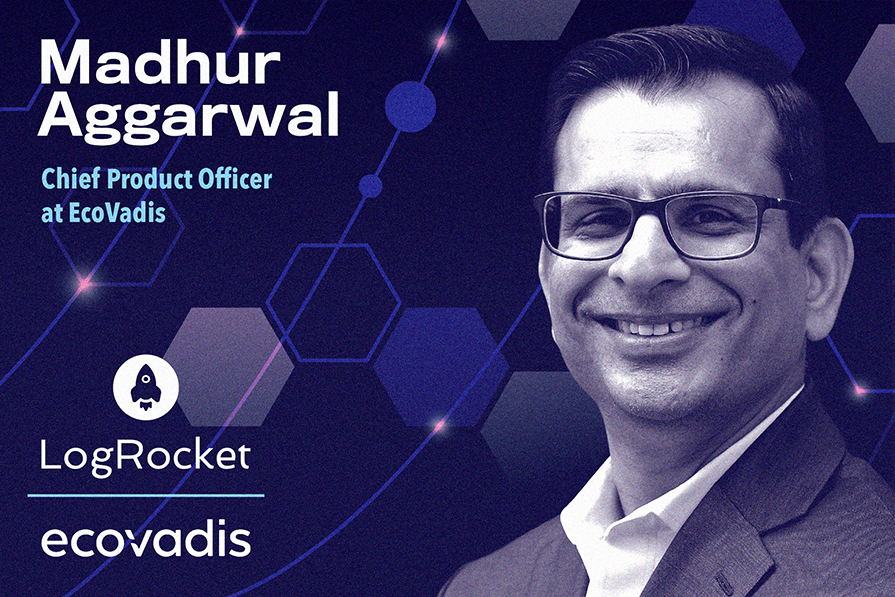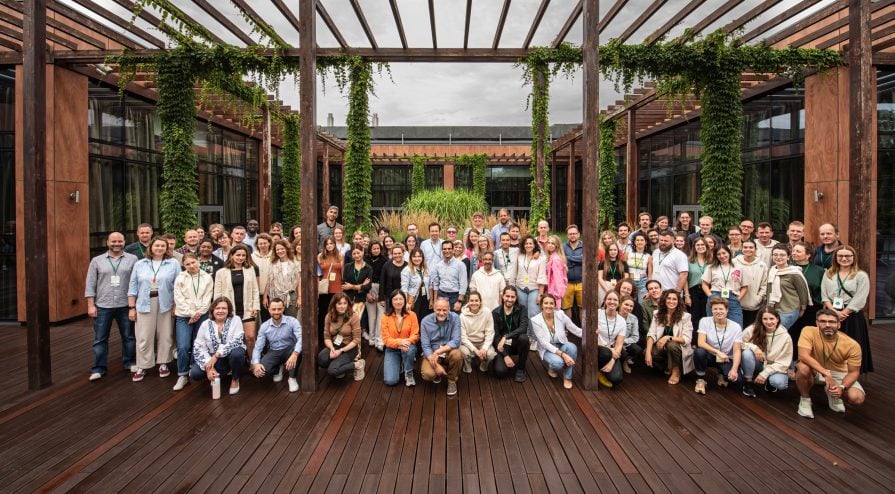Madhur Aggarwal is Chief Product Officer at EcoVadis, a software company focused on sustainability intelligence, where he leads a global team of 100+ product managers and designers. Before joining EcoVadis, Madhur spent more than two decades in general management and product leadership for global companies across Europe and North America. Madhur was General Manager of SAP Digital Commerce, CPO of Pearson’s digital business, and SVP of Product at Pluralsight.

In our conversation, Madhur shares his view that the product manager should be general managers of their product and responsible for the business from end to end, as well as how he believes they are both changemakers and peacemakers.
I am the CPO at EcoVadis, which is a large sustainability climate tech firm headquartered in Paris. We have roughly $200 million in ARR and 1,800 employees. Before my role here, I spent a lot of time in product management at large enterprise software companies like SAP, as well as digital native software companies like Pluralsight.
I’ve spent time in both public and private equity-backed companies, as well as companies based in different geographies. I actually got into product management through customer-centric, customer-facing professional services roles. When I started my career in the ’90s, I was implementing software CRMs and supply chain software for companies before transitioning to strategy consulting. It was a lot of project management — implement this software, train people, and move on to the next project.
However, I realized that, as software became more prevalent, business models were becoming more embedded with and enabled by this technology. Product management, not project management, was thus the discipline to be in to help solve problems at scale, as opposed to doing them one-off.
The role of a product manager — at least in the software space — is to take the customer’s needs and convert them into solutions. In our context, you have to bring together the software service, content service, and service of service. The PM has always had an interesting job in marrying the art and science there. In fact, we call our product managers “solution managers” for exactly that reason — they bring together the solution. AI simply adds a layer on top of it to help us get there faster.
I tell people that a product manager is responsible end-to-end for anything that happens to or within the product. If we have an engineering problem, the product manager gets the call. If we have an awareness problem, the product manager gets the call. If the board wants an update, the product manager gets that call too. By definition, they are the focus point for anything that is related to their product, so it is only appropriate that they are also viewed as the overall business-accountable leader for it.
By having the responsibility for the profit and loss statement of the product line, they actually have the facts they need to make trade-offs. They understand how the product is doing from revenue, customer adoption, customer support, engineering, and implementation perspectives.
As a simple example, we may be OK with launching some features that are good enough. We may know that there’s a higher ratio of services and support per client and we may have to provide the customer with some additional tools. But the PM has to be able to make that trade-off. This is often better than launching what I refer to as “near-perfect features,” which go to the market too late and never get adopted by customers.
I’ll give two examples. The first one is from SAP, which is a large enterprise software company. When SAP releases products, it is always business- and mission-critical. We always had to consider that just about every customer had taken the product and tweaked it to the business process of their liking, and they were running mission-critical systems on that.
In a normal product, what you think of as an edge case becomes the defining usage. At Pearson, which is in the education space, we dealt with more traditional software. In education, the product is a book with content within a software container. You could never launch a book that says, “Hey, the content is good enough, it may be half of 80 percent of the way there. It’s good enough though.” You have to know when you are launching something before the school year or semester starts, that whatever you have is close to 100 percent completion.
The bigger factor is that now, you have to go 4.5 months (a full semester) without making any updates because you can’t push one mid-semester — or else, all of a sudden, you’ve pushed an update but the professor’s learning plan will still refer to chapter 12, even though it is now chapter 7. Most of us in software don’t think about that until we spend time working on it.
The product manager can be responsible for many things depending on the context and the industry they are in. Generally, I refer to them as both changemakers and peacemakers. They’re trying to push the frontiers and drive change overall, but they’re also trying to galvanize the organization and bring it along. The framework they have, what is important to them, and how they measure success becomes important.
At EcoVadis, our product leaders are responsible for five things: revenue outcome, customer satisfaction and churn, eNPS, delivery against roadmaps, and operations capacity. Each of those five things that product managers are responsible for can help keep the business on track from a high level, as well as within their teams.
Every product manager is trying to shepherd a lot of people, including engineering teams, marketing teams, sales enablement teams, and more. That’s where the whole P&L and the KPI framework comes into play. One of the things we do here with team building is similar to an all-hands, but it’s in the form of a weekly video. I’ve done it every week, even if I’m traveling. It’s three minutes or less, and I find that it keeps the connection going.
Part of the product manager’s role is to be visible and keep the connectivity high. If they do that, people stop speculating about what’s happening. A lot of organizations spend a lot of time trying to figure out what’s going on, and this eliminates that. The other thing that we do is bring everyone together annually. We’ll bring all of our product teams together. Earlier last month, we got everyone together in Poland. This is extremely energizing for people, and the teams naturally create and adopt that rhythm of creating the human connection.

So many companies have sustainability goals. As a fun fact, most of the sustainability efforts in a company focus on its carbon footprint, and 60–90 percent of that footprint belongs in its supply chain. We help companies figure out sustainability across 21 different dimensions — all the way from energy consumption, greenhouse gas (GHG) emissions, water biodiversity, land use, and human rights.
We look at those 21 criteria, engage with the supply chain of a large Fortune 500 or a Global 2000 company, and evaluate and assess the practices of their suppliers on these criteria. As I mentioned, one of them is energy management and GHG overall, which is for decarbonization. Only about 25 percent of suppliers actually track any sort of carbon footprint overall, and only 5 percent of them have set any reduction targets.
On behalf of the companies, we work with these suppliers to help them set goals and go about their decarbonization journey, give them tools, and provide software-based solutions to help them improve on any of these dimensions.
There are several areas that we see, but the two areas we see several customers paying attention to are GHG emissions, which relate to decarbonization efforts, and labor and human rights. A lot of companies, especially those with long or multi-tiered supply chains, want to focus on that and make sure that they actually are following not just the law, but fair practices.
At EcoVadis, we ask the companies we’re working with for evidence related to each of those dimensions, which our AI models then parse through. For example, a customer may say, “I have a policy on product use and end of life, and I have this ISO certificate to back that up.” Our AI models will read it and validate if it’s the correct certification with a valid date. AI helps take this unstructured data and provide an output for our team of analysts to understand.
What I’ve seen over the last 12–18 months is our customers demanding that AI be more integrated into our software solutions — not just from an analysis perspective, but also from an interface perspective. There’s been widespread interest in and adoption of that. One of our key product features is a scorecard, which gives a company an overall sustainability score, as well as a sub-score for each of the 21 dimensions.
It also provides suggested areas of improvement. It’s like reading an SAT report breakdown, but it’s very in-depth. In the SAT example, if you did well on the reading section but did less well on math, you could use AI to ask for more practice questions to improve your score. In our case, a company might have 3,000 suppliers, and our customers want to use AI within our software to reach into their document library and pull insights about the best practices that their suppliers are using.
The strongest quality of AI at this point in time, specifically with OpenAI, is the availability of off-the-shelf language models. They’re getting more powerful by the day. I think the biggest thing, for anyone who’s actually getting into it, is the democratization of AI access. That’s the biggest advantage. However, there is always room to improve. These models have not been trained on our own data.
In our case, as an example, AI has not been trained to understand the data of the two million suppliers that we have in our network. It also doesn’t understand that the same supplier can have a very different relationship with one company versus another, different company. It doesn’t understand the context well enough. OpenAI has a way to go in adapting to industry-specific context, but it will get there fast.

LogRocket identifies friction points in the user experience so you can make informed decisions about product and design changes that must happen to hit your goals.
With LogRocket, you can understand the scope of the issues affecting your product and prioritize the changes that need to be made. LogRocket simplifies workflows by allowing Engineering, Product, UX, and Design teams to work from the same data as you, eliminating any confusion about what needs to be done.
Get your teams on the same page — try LogRocket today.

A practical framework for PMs to use AI in ideation without sacrificing judgment, strategy, or decision quality.

A practical five minute revenue estimation method to help product managers compare ideas, drop low impact features, and prioritize smarter.

A practical guide for PMs who want to stop being bottlenecks, delegate smarter, and lead teams effectively with a clear ownership framework.

Stop letting unreliable data block features. Treat data as inventory to track quality, ownership, and ship with confidence.